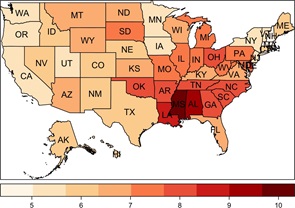Research Article
The influence of health insurance enrolment on maternal and childcare use in Nigeria
Purpose: Health insurance reduces the cost of using modern maternal and child cares and encourages women to use modern care services. This is because health insurance scheme spread the burden of maternal care usage across people and overtime. In Nigeria, there is a dearth of research evidence on the effect of health insurance enrolment on maternal and childcare use. This study examined the effect of health insurance coverage on maternal and childcare use in Nigeria, drawing upon data from the most recent National Demographic and Health Survey (2018).
Methods: Three outcome indicators were used: a minimum of four antenatal care (ANC) visits, place of delivery, and complete child immunization. Descriptive and predictive analytical methods were utilized. A representative sample of 33,715 women who reported recent birth within the last five years preceding the Survey was used for the analyses. Analyses were undertaken using STATA version 13.0 for windows.
Results: The results showed that 57% of the women made a minimum of four ANC visits, 41% delivered in health institutions, and 27% undertook complete child immunization. Enrolment in health insurance was low as only 2.3% of the women were under any form of health insurance coverage. However, enrolment in health insurance significantly improves the odds for a minimum of four ANC visits [aOR: 1.52, р = 0.00] and health facility delivery [aOR: 1.42, р = 0.00]. However, there is no significant difference in complete child immunization between women who were under health insurance and those who were not [aOR: 1.36, р = 0.28]. Also, residing in an urban area, Southern geopolitical zones, and being drawn from wealthy homes confer an advantage on women to use modern maternal and child healthcare.
Conclusion: Pragmatic interventions should be initiated to encourage women’s enrolment in health insurance in Nigeria. Community-based health insurance scheme should be encouraged among rural women and those of them in the informal sector
Marketing pattern for providing health tourism services in Iran
Health Tourism Services in Iran
Health tourism provides significant economic, political and social benefits to the active countries, which should be considered in a competitive market. Today, the medical tourism market is considered as one of the most lucrative and competitive industries in the world and is one of the new advanced fields of tourism. This is a descriptive study based on the method of research, and considered as a practical and cross-sectional point of view. This study demonstrates the importance of the mentioned factors in the proposed pattern of health tourism marketing, which should be emphasized by managers in the field of health tourism for short-term and long-term planning to develop it. In the stage of exploratory factor analysis, the “promotion” components with 8 variables, “procedures” with 13 variables, “partnership” with 6 variables, “evidence and symptoms” with 4 variables, “medical package” with 5 variables, “product” with 8 variables, “attention to cultural and medical sensitivities”With 6 variables, “cost” with 5 variables, “People” with 5 variables, and a proposed pattern including 9 factors with 60 items after confirmatory factor analysis Confirmed.
Five evidences on labour productivity and inequality in Italy
In the past two decades, Italy experienced a deceleration in labour productivity growth accompanied by persistently high income inequality. In this paper, we analyze five main empirical evidences for Italy indicating possible common determinants and linkages between productivity growth and income inequality in the period 1995-2018. To the best of our knowledge, the literature investigating this relationship for Italy is still very scarce. According to our preliminary exploration, the association between Italian productivity growth and income inequality between 1995 and 2018 has been mostly negative. This evidence suggests that the gloomy dynamics of productivity might have been an obstacle to income inequality reduction. There is also the possibility, however, that income inequality itself was among the causes of the gloomy productivity growth.
An evaluation of social assistance programs on infant health
Policymakers have been debating the value of social assistance programs, specifically whether they create a dependence resulting in unnecessary waste. We examine the impact of targeted social assistance programs on infant health, while also accounting for variations in sociodemographic and economic factors across the nation. Using information from the Centers for Disease Control (CDC), we combine information on infant health with data on state social assistance programs taken mostly from the University of Kentucky’s Center for Poverty Research between the years 1998 and 2015 for all US states. We find that an increase in TANF and SNAP generosity within a state is associated with an improvement in infant health. Our findings demonstrate the need for a social safety net to help the less fortunate and keep a productive society healthy.
This paper examines the relationship between construction workers work-life balance and productivity in the construction industry in Ghana. Survey method was adopted where 200 Questionnaires were administered to small and medium construction firms and 150 response were obtained. Canonical correlation analysis (CCA) was also carried out to establish the relationship between the predictor (WLB) and criterion latent variable set (Productivity). It emerged that there is a relationship between construction workers work life balance and productivity in the construction industry. This work strives to engender a wider academic debate and renewed the need for work life balance policies that will enhance productivity to be revisited. Management of construction organisations must develop and implement construction workers work-life balance polices at their place of work.



 Rolle Remi Ahuru, Daniel Osaze, Akpojubaro Henry Efegbere
Rolle Remi Ahuru, Daniel Osaze, Akpojubaro Henry Efegbere




